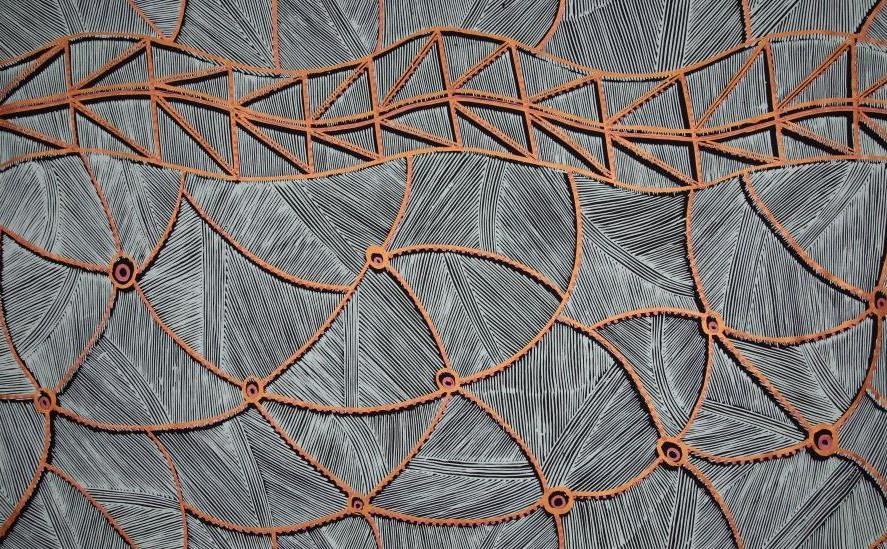It’s taken over a year to organise the trip for key artists Deborah Wurrkidj, Jennifer Wurrkidj, Elizabeth Kala Kala, Janet Marawarr and Jacinta Lamilami that enables them to see their textile designs in the exhibition, alongside the work of 12 other artists from the Bábbarra Women’s Centre.
Earlier this year, Bábbarra’s crowdfunding campaign raised $35,000 to supplement funding from the Australia Council and Arts NT. The centre also negotiated the lengthy process of getting passports for the artists – figuring out, for example, how to provide valid addresses when the town does not have street names, and when a visit to the passport office means an eight-hour drive to Darwin.
‘Every design has a story and it’s important that we continue telling these stories of Country, dreamtime, bush food, ancestors and identity.’
Jessica Phillips
The exhibition opens on 3 October and is being met with huge excitement by the artists. ‘Very happy,’ said Janet Marawarr about the trip. ‘Big place, Paris. I’m feeling a little frightened but feeling good. Feeling proud, my design in Paris.’
Ongoing connection to country
The 32 textile designs, some of which are several metres long, will be hung from the ceiling and around the walls. The centre began screenprinting in the 1990s and has steadily built up a library of screens that range in complexity from one to four colour designs.
One of the earliest in Jarracharra is Dora Diaguma’s Murnubbarr Karrolka (Flying Magpie Geese) from 2003. There are also designs that reflect the artists’ ongoing connection to country and culture, like Janet Marawarr’s spiralling, wind-inspired Kunkurra designs, Elizabeth Kala Kala’s Kunmadj dillybag prints and Deborah Wurrikidj’s Yawkyawk spirits.

Jennifer Wurrkidj, Deborah Wurrkidj and Janet Marawarr at the 2017 Karrang Kunred exhibition, Sydney. Image Bábbarra Designs (Arts & Culture – BAC).
The title of the exhibition, Jarracharra, is a Burarra word for the cool wind that marks the start of the dry season. Burarra woman Jessica Phillips is the centre’s Assistant Manager and describes this wind as a ‘sign of change’ and a time for ceremony, song and cultural dance. She said that it’s also a time when people to travel between homelands and country.
Bábbarra is run by women for women, operating under the Aboriginal-owned Bawinanga Aboriginal Corporation, and is one of a small number of art centres producing textile arts. In the past five year, the visibility of these centres has increased dramatically.
Blurring divisions and highlighting diversity
This rise goes hand in hand with the blurring of old divisions between the art and fashion worlds, as art fairs like the Cairns Indigenous Art Fair showcase First Nations textiles and fashion alongside contemporary art. It’s also been helped by professional online shops, which have expanded their market to home sewers and others.
‘It brings joy to the artists that people from all around the country are interested in wearing their designs,’ said Phillips. ‘The more we sell the fabrics, the more it encourages women to print and create new designs.
‘Every design has a story and it’s important that we continue telling these stories of country, dreamtime, bush food, ancestors and identity. These artists enjoy passing on knowledge through what they love doing – and that’s printing.’

Screen printing at Bábbarra Womens Centre, Maningrida. Image by Ingrid Johanson.
The Bábbarra designs also speak to the huge cultural diversity in Maningrida. The town itself is on Ndjébbana country, but the community of 2500 is home to about 80 clan groups and 12 languages.
The five artists travelling to Paris this year – the year of Indigenous languages – speak Kuninjku, Mayali, Ndjébbana, Kune, Gun-nartpa, Rembarrnga and Kriol between them. A glossary of key terms in some of these different languages spoken in Maningrida is included in the Jarracharra catalogue.
Jarracharra runs 3 October 2019 to 10 January 2020 at the Australian Embassy in Paris. The visiting artists will perform their traditional dance and songlines at the exhibition opening, including Wurrurrumi song cycle belonging to Western Arnhem Land.





